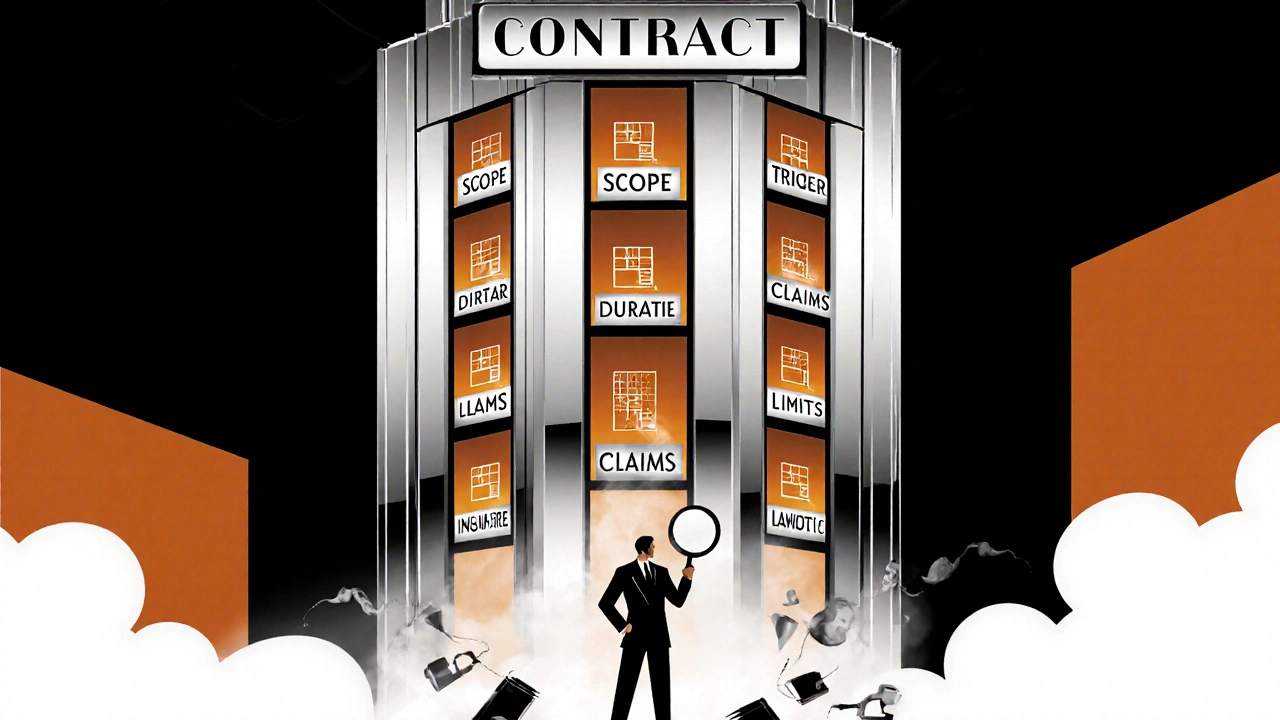Liability and Indemnification in Generic Transactions: What You Need to Know
 Nov, 19 2025
Nov, 19 2025
When two parties sign a contract-whether it’s a software license, a merger, or a simple service agreement-they’re not just agreeing on price or delivery dates. They’re also deciding who will pay if something goes wrong. That’s where liability and indemnification come in. These aren’t just legal buzzwords. They’re the backbone of risk management in every commercial deal. If you’ve ever wondered why a vendor insists on indemnifying you against lawsuits, or why your lawyer spends hours tweaking a single clause, this is why.
What Indemnification Actually Means
Indemnification is a promise. One party agrees to cover the other’s losses if certain things happen. It’s not insurance, but it works like it. If your software provider gets sued because their code violates someone’s patent, and your contract includes an indemnification clause, they’re on the hook for your legal bills, settlement costs, or even lost revenue.
The legal definition is simple: to indemnify means to compensate someone for losses they’ve suffered due to a specific event. According to Cornell Law School’s Legal Information Institute, it’s about making someone whole again after financial harm. But in practice, it’s more complex. It’s not just about paying money. It’s about control, timing, and limits.
The Seven Core Parts of an Indemnification Clause
Not all indemnification clauses are the same. A well-drafted one includes seven key elements:
- Scope of Indemnification - What exactly is covered? Legal fees? Third-party claims? Damages from negligence? The clause must list these clearly. Vague language like “any losses” invites disputes.
- Triggering Events - What makes the indemnification kick in? A breach of contract? A data leak? A tax audit? The clause must tie the obligation to specific actions or failures.
- Duration - How long does this protection last? Some clauses expire when the contract ends. Others survive for years-especially for fundamental issues like ownership of assets or tax liabilities.
- Limitations and Exclusions - Not every loss is covered. Many contracts exclude indirect damages (like lost profits) or punitive damages. There’s often a cap too-say, the total contract value.
- Claims Procedure - You can’t just send a bill. You have to notify the other party within a set time (often 30 days), provide details, and give them a chance to respond. Miss the deadline, and you might lose your right to claim.
- Insurance Requirements - Does the indemnifying party need to carry insurance? If so, what kind? General liability? Cyber liability? The policy limits should match the potential exposure.
- Governing Law and Jurisdiction - If a dispute arises, where will it be resolved? In California? New York? Which state’s laws apply? This matters because rules vary by location.
These seven parts aren’t optional. Skip one, and the whole clause could become unenforceable-or worse, open to abuse.
Indemnify, Defend, Hold Harmless: What’s the Difference?
People use these terms interchangeably, but legally, they mean different things.
- Indemnify means pay for losses. If you’re sued because of the other party’s mistake, they pay your settlement.
- Defend means pay for legal costs. This includes attorney fees, court filings, discovery expenses-even if you win the case.
- Hold harmless means you can’t sue them back. If you cause the problem but they’re still required to cover your costs, this clause stops them from turning around and blaming you.
Many contracts say “indemnify, defend, and hold harmless.” That’s redundant in some states, but it’s still common. Lawyers include all three to cover every possible interpretation. But if you’re negotiating, focus on what’s actually needed. Do you need them to defend you? Or just pay you after the fact?

Mutual vs. Unilateral Indemnification
Not all deals are equal. Who’s expected to indemnify whom depends on power dynamics.
Unilateral indemnification is the norm in most vendor-customer deals. The vendor promises to protect the customer. Think of a SaaS company indemnifying a Fortune 500 client against IP infringement claims. The vendor has more control over the product, so they take the risk.
Mutual indemnification is rarer. Both sides protect each other. This happens in joint ventures, construction contracts, or partnerships where both parties could cause harm. For example, if a contractor injures a subcontractor, and the client’s site conditions contributed, both might owe each other compensation.
But mutual clauses are dangerous if not balanced. If both sides have weak insurance or deep pockets, you could end up in a legal ping-pong match. Always check: who has the most to lose? Who controls the risk? That’s who should bear the responsibility.
Fundamental vs. Non-Fundamental Representations
In mergers and acquisitions, indemnification ties directly to what’s called “representations and warranties.” These are promises the seller makes about the business: “We own all our IP,” “We have no hidden debts,” “Our employees are properly classified.”
There are two types:
- Fundamental reps - Core truths. Ownership of assets, corporate authority, tax compliance, no undisclosed liabilities. These survive for years-often 3 to 6 years after closing.
- Non-fundamental reps - Operational details. Employee benefits, minor contracts, environmental compliance. These usually expire after 12 to 18 months.
Why the difference? Fundamental reps go to the heart of the deal. If the seller didn’t own the company’s main product, the whole transaction collapses. Non-fundamental reps are about day-to-day operations. They matter, but not as much.
Buyers push for longer survival periods on fundamental reps. Sellers push back. That’s where negotiation happens. The cap on liability often ties into this too. For fundamental reps, the cap might be 100% of the purchase price. For non-fundamental, it might be 10%.

How to Negotiate Indemnification Without Losing the Deal
Indemnification clauses are the most heavily negotiated part of any contract. Here’s how to handle them without stalling the deal:
- Start with market norms - What’s typical in your industry? In software deals, vendor indemnifies buyer for IP claims. In construction, mutual indemnity is common. Don’t try to reinvent the wheel.
- Focus on trigger events - Narrow the list. Instead of “any breach,” say “material breach of representations.” Avoid open-ended language.
- Set a deductible (basket) - Many contracts include a threshold. No claim until losses hit $50,000. This prevents small disputes from becoming lawsuits.
- Cap the liability - Limit exposure. A $10M deal shouldn’t carry $50M in potential indemnity. Caps are usually 10-100% of the deal value, depending on risk.
- Require insurance - Don’t rely on promises. Ask for proof of coverage. If they’re a startup with no insurance, demand a parent company guarantee or escrow funds.
- Control the defense - If you’re the indemnitee, insist on the right to choose your own lawyer. If you’re the indemnifier, demand control to keep costs down.
Remember: no one walks away from a deal because of indemnification. But people walk away because they feel exposed. Clarity beats aggression.
What Happens If There’s No Indemnification Clause?
Some people think, “We’re on good terms. We don’t need this.” That’s a mistake.
Without a clause, you’re stuck with common law rules. That means:
- You can only recover damages if you prove negligence or fraud.
- You can’t recover legal fees unless a statute allows it.
- You have no guaranteed timeline for payment.
- You might need to sue to get anything.
Indemnification removes guesswork. It turns a risky, unpredictable situation into a clear, enforceable obligation. In a world where lawsuits are expensive and slow, that’s worth more than a signed handshake.
Real-World Example: A Data Breach
Imagine you’re a retailer. You hire a cloud provider to store customer data. Their system gets hacked. 10,000 customers’ credit card info is stolen. You get sued. You pay $200,000 in notification costs, legal fees, and credit monitoring.
If your contract says the provider must indemnify you for data breaches caused by their negligence, you submit a claim. They pay. Simple.
If there’s no clause? You pay. Then you sue. You spend another $100,000 on lawyers. You win-but it takes two years. And you’re out $300,000.
Indemnification isn’t about distrust. It’s about planning for the worst.
Is indemnification the same as insurance?
No. Insurance is a third-party policy that pays out based on coverage terms. Indemnification is a contractual promise between two parties. One party agrees to pay the other if a specific event happens. Insurance can back up an indemnification clause, but it doesn’t replace it.
Can I limit my indemnification obligations?
Yes. Common limits include: a monetary cap (e.g., 100% of the contract value), a deductible (e.g., no claim unless losses exceed $25,000), exclusion of indirect damages (like lost profits), and a time limit (e.g., claims must be made within 18 months). Always negotiate these upfront.
What if the indemnifying party goes bankrupt?
Then you’re out of luck unless you have collateral or insurance. That’s why requiring proof of insurance or a parent company guarantee is critical. If you’re the buyer and the seller is a small company, don’t rely on their promise alone. Demand financial backing.
Do I need a lawyer to draft an indemnification clause?
Yes. Even if you use a template, a lawyer should review it. Courts interpret these clauses strictly. Ambiguous language can void the entire provision. A poorly written clause can cost more than it saves.
Are indemnification clauses enforceable in all states?
Most are, but rules vary. Some states limit indemnification for gross negligence or willful misconduct. Others require explicit language to cover attorney fees. Always specify governing law in the contract to avoid uncertainty.
Alyssa Torres
November 20, 2025 AT 18:53This post is a game-changer. I used to think indemnification was just legal jargon to scare small businesses, but now I get it-it’s about protecting your sanity when things go sideways. I’ve seen startups get crushed because they didn’t have a clear clause, and honestly? It’s not about distrust. It’s about not being blindsided.
When I worked at a SaaS company, our client demanded indemnification for IP infringement. We pushed back at first-‘We’re just a tiny team!’-but then we realized: if they get sued because of our code, we’re already dead anyway. So we added insurance requirements and capped liability at 150% of the contract. It didn’t kill the deal. It made it *real*.
Summer Joy
November 21, 2025 AT 10:56OMG I’m literally screaming at my screen right now 😭😭😭
Why do lawyers make everything sound like a 50-page novel?? I just want to know if my $500 cloud service will cover me if their server gets hacked. NOBODY TELLS YOU THIS STUFF UNTIL YOU’RE IN COURT WITH A $200K BILL 😭
Aruna Urban Planner
November 23, 2025 AT 06:19The structural asymmetry in unilateral indemnification reflects broader power imbalances in contractual relationships. In many emerging economies, SMEs are forced into indemnity obligations they cannot enforce, due to lack of legal recourse or insurance infrastructure. The clause becomes performative rather than protective.
It’s not merely about drafting-it’s about institutional capacity. A clause requiring ‘proof of cyber liability insurance’ is meaningless if the indemnifying party operates in a jurisdiction where such policies are unavailable or unaffordable. The law must evolve to account for this asymmetry, or indemnification becomes a tool of extraction, not risk mitigation.
Nicole Ziegler
November 23, 2025 AT 15:43indemnify 🤝 defend 🤝 hold harmless
so many emojis in my head right now 😵💫🤯💼
also… why does every contract feel like a horror movie? 🎬
Bharat Alasandi
November 25, 2025 AT 06:43bro this is exactly what we deal with daily in India. Vendor says ‘we indemnify’ but has no insurance, no assets, just a WhatsApp number. We had a client last year get sued for a third-party API breach-vendor vanished. No clause = no safety net.
My advice? Always ask for bank guarantee or parent company backing. No exceptions. Even if it’s a ‘small deal.’
Also-deductible is your friend. $10k threshold? Saves so much drama.
Kristi Bennardo
November 26, 2025 AT 00:10This article is dangerously oversimplified. Indemnification clauses are not ‘seven parts’-they are legal minefields disguised as boilerplate. The notion that ‘clarity beats aggression’ is naive. In high-stakes M&A, ambiguity is weaponized. The party with more leverage doesn’t clarify-they bury the risk in sub-clauses buried in Exhibit B.
And please. ‘Mutual indemnity’? That’s just a fancy way to say ‘let’s both sue each other until we’re bankrupt.’ I’ve seen it. It’s ugly. And this post makes it sound like a TED Talk.
Shiv Karan Singh
November 26, 2025 AT 14:46lol everyone here acting like indemnification is some deep secret. it’s just corporate theater. vendors promise to indemnify so they can charge more. buyers demand it so they feel safe. neither side actually expects to collect.
if you think your contract will save you from a data breach, you’re delusional. the real protection? not using shady vendors. no clause fixes bad decisions.
also… why do lawyers even exist? they invented this mess.
Ravi boy
November 26, 2025 AT 21:25man i read this whole thing and i still dont get why we need all this legalese
just say if you mess up you pay
why does it need 7 points and 3 phrases and insurance and jurisdiction and caps and baskets and all that
its just common sense
also typo in paragraph 3 lol
but hey at least its better than the contract my cousin signed with that crypto startup
Matthew Karrs
November 28, 2025 AT 13:24Of course this article makes indemnification sound reasonable. Because the people who wrote it are the ones who benefit from it.
Let me guess-lawyers wrote this. They profit from complexity. They want you to believe that without a 12-page indemnity clause, you’re doomed.
But here’s the truth: 95% of indemnification claims never get paid. The indemnifying party goes bankrupt, disappears, or ‘misunderstands’ the clause. The rest? They fight it for 5 years in court.
Indemnification isn’t protection. It’s a psychological comfort blanket for people who don’t trust capitalism.
Also-why is this post so long? Did someone get paid per word?
Matthew Peters
November 28, 2025 AT 20:24Okay but what about the weird edge cases? Like if you indemnify someone for IP infringement… but the IP was created by a freelancer who didn’t assign rights properly? Who’s liable then?
And what if the indemnifying party is a shell company with no assets? Does the clause even mean anything?
I’ve been on both sides of this. The ‘indemnify’ clause feels great on paper… until the day you realize the other side is a ghost.
Real talk: the only thing that matters is insurance + parent company guarantee. Everything else is theater. Lawyers just love making it complicated so they can bill you more.
Also-why does no one ever talk about how long these survive? I thought 3 years was standard, but I just found a clause that lasted 7. What even is that?